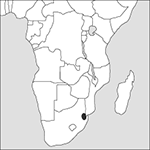
Source: MAPS IN MINUTES™ © RH Publications (1997)
Capital:
Mbabane (administrative); Lobamba (royal and legislative)
Area:
17,364 sq km (6704 sq miles)
Population:
1,403,362 (2013 est)
Currency:
1 lilangeni = 100 cents
Religions:
African indigenous churches 40.0%; Roman Catholic 20.0%; Muslim 10%
Ethnic Groups:
African 97.0%; European 3.0%
Languages:
English, siSwati (both official)
International Organizations:
UN; AU; Commonwealth; SADC; Non-Aligned Movement; WTO
A small country of southern Africa.
Physical
Swaziland is landlocked by South Africa on three sides and by Mozambique on the east. In the west are well-watered hills, rich in iron ore, from which run several rivers to the dry veld in the middle of the country. Here a variety of crops is grown, on the lower plains in the east there is livestock farming and cultivation of sugar cane.
Economy
The economy is heavily dependent on South Africa, which is Swaziland’s dominant trading partner; many Swazis find work in South African mines, and much of Swaziland’s electricity is imported from South Africa. The main export is sugar, with sugar cane being the principal crop. Other crops include cotton, maize, tobacco, rice, fruit, sorghum, and groundnuts. Wood pulp used to be a leading export, but the last mill closed in 2010. Industrial products include coal, soft drink concentrates (Coca-Cola and others have moved plants from South Africa to make use of cheap sugar), textiles, and clothing. The textile and clothing industries were damaged by the removal of duty-free access to US markets in 2015, because of Swaziland’s poor democratic record. About two-thirds of the population is employed in subsistence agriculture.
History
Swaziland takes its name from the Swazis, who probably moved into the area during the 16th century. The name is thought to have been given to the people in 1836 when Mswati (Mswazi) II became king. A South African protectorate from 1894, Swaziland came under British rule in 1902 after the Second Boer War, retaining its monarchy. In 1968 it became a fully independent kingdom under Sobhuza II (1921–82). Revisions of the constitution in 1973 in response to requests from its Parliament, and again in 1978, gave the monarchy wide powers. All political parties were banned under the 1978 constitution. As a result, King Mswati III, who succeeded in 1986, faced increasing demands (1991–92) for the introduction of democracy. Parliamentary elections were held on a non-party basis in 1993, but were widely held to be undemocratic. A new constitution took effect in 2006, but left the King with near absolute power. HIV/AIDS was a major threat to Swaziland in the early 21st century: in 2014 a quarter of the population was infected, the highest rate in the world. Swaziland’s economy is currently in a parlous state, with unemployment at around 30 per cent and government revenues and reserves insufficient to meet the country’s needs.
- geopolitik
- George I (1660–1727)
- George II (1683–1760)
- George II (1890–1947)
- George III (1738–1820)
- George IV (1762–1830)
- George V (1865–1936)
- George VI (1895–1952)
- George W. Snedecor Award
- Georgia
- georgiaite
- Georgian epoch
- geosciences
- geosophy
- geospatial
- geospatial intelligence
- geospatial technologies
- geosphere
- geostatic stress
- geostationary earth orbit
- Geostationary Meteorological Satellite
- Geostationary Operational Environmental Satellite
- Geostationary Operational Meteorological Satellite-2
- geostationary orbit
- geostatistics